
The Southern Expeditionary Army Group was a general army of the Imperial Japanese Army during World War II. It was responsible for all military operations in South East Asian and South West Pacific campaigns of World War II. Its military symbol was NA.

The Philippines campaign, also known as the Battle of the Philippines or the Fall of the Philippines, was the invasion of the American territory of the Philippines by the Empire of Japan and the defense of the islands by United States and the Philippine Armies during World War II.

The Battle of Bataan was fought by the United States and the Philippine Commonwealth against Japan during World War II. The battle represented the most intense phase of the Japanese invasion of the Philippines during World War II. In January 1942, forces of the Imperial Japanese Army and Navy invaded Luzon along with several islands in the Philippine Archipelago after the bombing of the American naval base at Pearl Harbor.
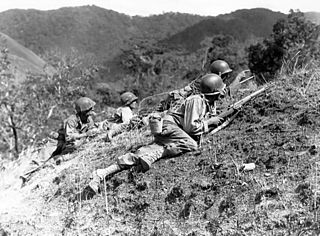
The Battle of Luzon was a land battle of the Pacific Theater of Operations of World War II by the Allied forces of the U.S., its colony the Philippines, and allies against forces of the Empire of Japan. The battle resulted in a U.S. and Filipino victory. The Allies had taken control of all strategically and economically important locations of Luzon by March 1945, although pockets of Japanese resistance held out in the mountains until the unconditional surrender of Japan. While not the highest in U.S. casualties, it is the highest net casualty battle U.S. forces fought in World War II, with 192,000 to 217,000 Japanese combatants dead, 8,000 American combatants killed, and over 150,000 Filipinos, overwhelmingly civilians who were murdered by Japanese forces, mainly during the Manila massacre of February 1945.
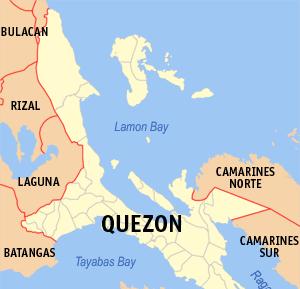
Lamon Bay is a large bay in the southern part of Luzon island in the Philippines. It is a body of water connecting the southern part of Quezon province to the Philippine Sea, a marginal sea of the Pacific Ocean. It borders on the coastal towns of Atimonan, Gumaca, Plaridel, Lopez, Calauag, and the islands of Alabat.

USS Owl (AMCU-35) was a LCI(L)-351-class large landing craft of the United States Navy, later converted to an AMCU-7-class coastal minesweeper.

The 24th Pursuit Group is an inactive United States Air Force unit. It was wiped out in the Battle of the Philippines (1941–42). The survivors fought as infantry during Battle of Bataan and after their surrender, were subjected to the Bataan Death March, although some did escape to Australia. The unit was never remanned or equipped. It was carried as an active unit until 2 April 1946.

Quezon, officially the Province of Quezon, is a province in the Philippines located in the Calabarzon region on Luzon. Kalilayan was the first known name of the province upon its creation in 1591. Around the middle of the 18th century, it was changed to Tayabas. In recognition of the second president of the Philippines, Manuel L. Quezon, the name of Tayabas Province is changed to Quezon. Lucena, the provincial capital, the seat of the provincial government, and the most populous city of the province, is governed independently from the province as a highly urbanized city. To distinguish the province from Quezon City, it is sometimes called Quezon Province, a variation of the province's official name.
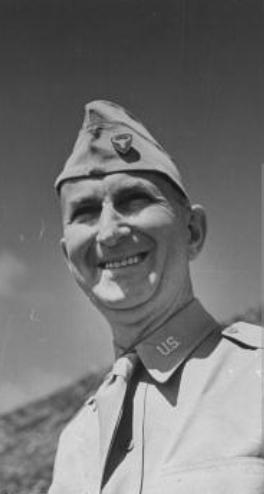
George Marshall Parker Jr. was an officer of the United States Army with the rank of major general. General Parker commanded the Philippine II Corps during the Battle of Bataan.

The Japanese Invasion of Aparri on 10 December, 1941, was one in a series of advance landings made by Imperial Japanese forces as a first step in their invasion of the Philippines. The purpose was to obtain control of local air strips, which could be used as forward bases by fighter aircraft for operations further south. The first invasion was at Batan Island on 8 December 1941. This was followed by Vigan, Legaspi, Davao, and Jolo Island over the next few days

The Japanese Invasion of Vigan on 10 December 1941 was one in a series of advance landings made by Imperial Japanese forces as first step in their invasion of the Philippines. The purpose was to obtain control of local air strips, which could be used as forward bases by fighter aircraft for operations further south. The first invasion was at Batan Island on 8 December 1941. This was followed by Vigan, Aparri, Legaspi, Davao, Jolo Island over the next few days

The Japanese Invasion of Legazpi on 12 December 1941 was one in a series of advance landings made by Imperial Japanese forces as first step in their invasion of the Philippines. The purpose was to obtain control of local air strips, which could be used as forward bases by fighter aircraft for operations in central Luzon. Control of Legazpi was an important point in the Japanese strategy, as it would also give them control of San Bernardino Strait, between the islands Luzon and Samar, which would prevent the Americans from bringing in reinforcements from the south. The first invasion was at Batan Island on 8 December 1941. This was followed by Vigan, Aparri, Legazpi, Davao, and Jolo Island over the next few days

The Japanese invasion of Lingayen Gulf was the key point in the Japanese plan for the conquest of the Philippines. Preparations had already been made by the Attack on Clark Field and the landings of Japanese forces at five points in northern and southern Luzon and Mindanao in early/mid December 1941, with the IJAAF seizing air fields and basing aircraft for ground support, and the Imperial Japanese Navy establishing seaplane bases at the Camiguin Island, Legaspi, and Davao. The main landing of Japanese forces targeted Lingayen Gulf, with its proximity to the Philippine capital of Manila, and Lamon Bay on the opposite coast to the south.

The Japanese Invasion of Davao and on Jolo in the Sulu Archipelago on 19 December 1941 was one in a series of advance landings made by Imperial Japanese forces as first step in their invasion of the Philippines. The purpose was to cut off the possibility of reinforcements reaching Luzon from the south and to complete the encirclement of American forces there, with the secondary purpose of establishing a base from which the IJA 16th Army could launch an invasion of British North Borneo and the Netherlands Indies. The first invasion of the Philippines was at Batan Island on 8 December 1941. This was followed by Vigan, Aparri, Legaspi, Davao, and Jolo over the next few days

The Japanese invasion of Batan Island was the first step in their invasion of the Philippines, an American commonwealth territory. The U.S. had acquired the former Spanish colony half a century earlier, when it defeated Spain in the Spanish-American War. The purpose was to obtain control of local airstrips which could be used as forward bases by fighter aircraft for operations further south in the Philippines. The attack on Batan Island was the first of several other advance landings; the other landings took place at Aparri, Vigan, Legaspi, Davao, and Jolo Islands.
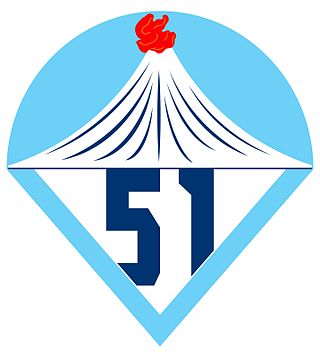
The 51st Infantry Division was a division of the Philippine Army under the United States Army Forces in the Far East (USAFFE).

The 21st Infantry Division was one of the 10 reserve division of the Philippine Army mobilized under the United States Army Forces in the Far East (USAFFE). The unit was involved in the delaying action against the Japanese invasion in the plains of Central Luzon, and the Battle of Bataan in 1942.
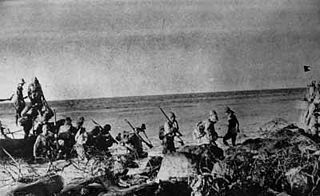
Kaimei Maru was a Japanese troop transport ship operated by the Imperial Japanese Army during World War II which was sunk off Honshu on 4 September 1942 by the American submarine USS Guardfish. The ship was a British WWI Type B military cargo ship built by the Hong Kong and Whampoa Dock Company.
Fukuei Maru No. 15 was a Japanese cargo ship that was requisitioned by the Imperial Japanese Navy during World War II and converted into an auxiliary netlayer.
South Luzon Force was a corps-sized unit of the US Army Forces Far East (USAFFE) active in the Philippines between 1941 and 1942. Created along with other 3 commands under the USAFFE, it was officially announced on November 4, 1941, and BGen. George M. Parker was appointed to command, making him responsible for the defense of Southern Luzon of any invasion. General Parker established his headquarters in Fort William McKinley in Rizal province.
















